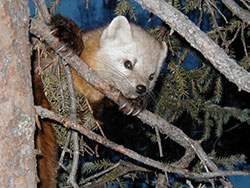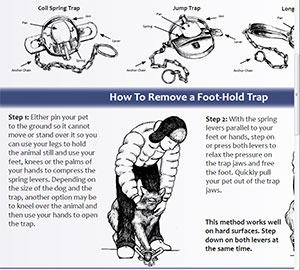Alaska Fish & Wildlife News
January 2014
Trapping, Trails and Dogs

Winter is trapping season in Alaska, and dog owners sometimes worry that a pet could be caught in a trap. That’s unlikely to happen for a variety of reasons, but Fish and Game and the Alaska Trappers Association are teaching people how to recognize traps, signs of trapping, and how to release a dog should it become trapped.
Biologist Stephanie Sell helped organize a “Sharing the Trails” seminar in Juneau in early November, a roughly two-hour class on a Wednesday evening. About 25 people attended, and three local trappers volunteered to help.
“A lot of people came out of it way more educated than they were when they went in. A lot of people really don’t know anything about trapping, and people were diving right into questions,” Sell said. “We had traps that people could handle, they could talk with the trappers, and we had a lot of tools they could use to get traps open – dog leashes and ropes, sticks, and things like that.
One trapper in particular made a good connection with the participants.
“Jessie started out with the trapper’s code of ethics, going through each one,” she said. “He told them, ‘We’re not out here to catch your dogs, I’m a dog owner, and when I started trapping, my dog got caught in a trap, and I know how mortifying it is. I was panicked, but in 30 minutes he was fine.’ He threw himself out there and people really appreciated it.”
Sell said this workshop in other communities can have a very different tone.

“Dog culture and the trapping culture are different in different places,” she said. “Some places, some people just open the door and let the dogs run loose, in other places people just don’t do that. And in some places you can trap really close to town, in town even, and other places you can’t.”
In Juneau, trapping is closed within ½ mile of any street or road - and within ¼ of the coast along the entire road system. This is a city ordinance. Other state and federal regulations apply as well and affect where trapping may occur – trapping is closed on the Mendenhall Wetlands State Game Refuge and the Mendenhall Glacier Recreation Area. Trapping is closed within ¼ mile of 20 designated popular trails -except small traps that are set at least five feet off the ground (primarily targeting marten) are allowed if they are at least 50 yards off the trail.
Different communities may apply different regulations, so the likelihood of encountering any trapping activity varies with the area.
Fish and Game has created a handy two-page brochure that details how to release a dog from a trap and offers basic information on how different traps work. It’s available online or in print (after about Jan. 13) at area offices.
The Alaska Trappers Association has produced a 30-minute video, "Sharing Alaska's Trails," to address concerns about dogs getting into traps.

"We want to be proactive and constructive about this," said Steve Davila, past president of the ATA. "This is part of our effort to eliminate or reduce the risk of pets getting caught, and conflicts on traplines."
Long-time Fairbanks trapper Pete Buist narrates the video. Buist, a hunting guide and former state game board member, is also a former president of the ATA. Buist has trapped for 40 years, and for 20 years he used a dog team to tend his trap line.
The video doesn’t show dogs caught in traps, or feature any footage that pet lovers might consider disturbing. It doesn’t promote trapping, but deals with the practicalities of sharing the trails.
The video highlights signs that a dog walker might see if he or she was near a trap line, such as a bird wing fluttering from a pole, survey tape or flagging and piles of bait. Trappers sometimes post notices alerting others to the presence of their line.
"Sharing Alaska’s Trails" also features Buist going over different types of traps and snares and how to release dogs from those traps. He also offers suggestions for subduing and handling dogs in traps.
"He demonstrates how to open them up, how the locks function on snares, diagrams of traps and what a set might look like," Davila said. A ‘set’ refers to a set trap.
An open caption version of the video is available as well.
Subscribe to be notified about new issues
Receive a monthly notice about new issues and articles.
